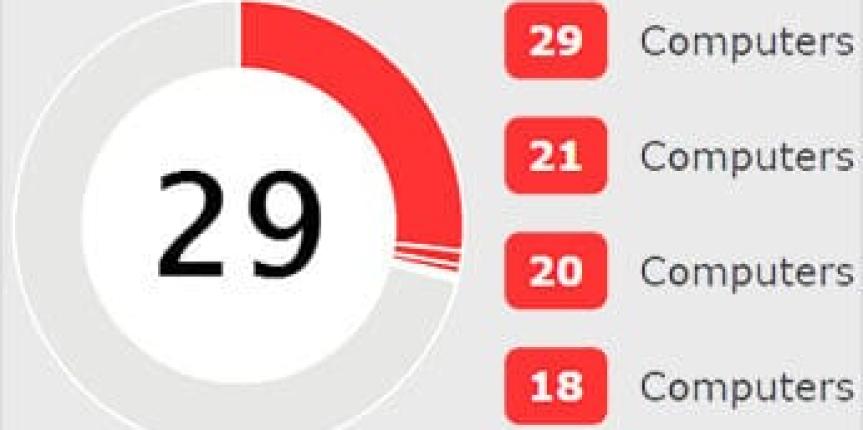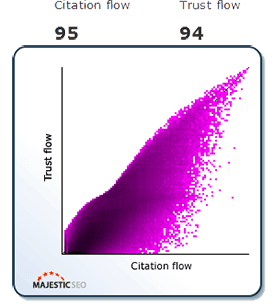
Majestic Seo provide an incredibly handy toolset for Seo practitioners, and their two most popular and important metrics are Trust Flow & Citation Flow. Let’s take a look at how both metrics are calculated.
Trust Flow is calculated using a (secret) set of highly authoritative seed websites as a baseline. The further away your domain is from these seed sites, the lower your domain’s trust flow will be. The seed set of authority sites link out to other good sites, and those sites link out to more good sites, etc. The closer your domain is to these seed sites, via inbound links, the higher your Trust Flow score will be.

I prefer to think of it this way; Trust Flow measures the quality of your inbound links based on the quality of the inbound links pointing to the site that your inbound links come from. To simplify it further, if all of your inbound links come from sites with high trust flow, then your domain will also have a high trust flow. That’s because the sites that your links come from also have great inbound links going to them.
Trust flow is quite a difficult metric to manipulate, and topical trust flow is virtually impossible to manipulate and inflate. You can easily check the topical trust flow of any site using the SEO chrome extension SerpWorx.
Topically matched trust flow means that the sites your links come from also have also have inbound links about the same topic. When your domain has high trust flow that is topically relevant, rankings come easily.
Topical trust flow isn’t calculated or dependant on the content of the site your links come from, its calculated from the topical relevance of the inbound links pointing to that site. If your site has an inbound link from a web page that’s all about Seo, then it doesn’t necessarily mean that particular link is going to increase the topical relevance of your trust flow. The site and page your link comes from may have inbound links coming from sites about dog training.
The reverse of this also holds true. If your SEO site has a link from a page that’s about mobile phones, but that site has inbound links from other SEO sites, then this link is still considered to be topical relevant. There are close to 1000 categories that Majestic has formulated to categorise the topical relevance of links. Their algorithmic formula can drill down pretty deep and is very accurate.
The three key points to remember about trust flow are:
- A high Trust flow means that your inbound links come from sites that also have very good inbound trustworthy links.
- A high topically matched trust flow means that the sites your inbound links come from also have topically relevant inbound links.
- The power of a domain’s ability to rank is greatly enhanced when it has topically matched inbound links coming from websites that also have topically matched inbound links.
What Exactly Is Citation Flow and How Does It Work?
 The Citation Flow metric is complimented by the Trust Flow metric. Citation Flow by itself isn’t a metric that sheds much light on the strength of a domain. Citation Flow is unbiased towards topical relevance and quality. It suffers from the same over generalisation inaccuracies as Moz’s Domain Authority metric.
The Citation Flow metric is complimented by the Trust Flow metric. Citation Flow by itself isn’t a metric that sheds much light on the strength of a domain. Citation Flow is unbiased towards topical relevance and quality. It suffers from the same over generalisation inaccuracies as Moz’s Domain Authority metric.
Citation Flow and Domain Authority are only as good as the source sites that are responsible for passing on those metrics to a domain. That’s why Trust Flow is such a powerful and complementary metric when used in combination with Citation Flow.
There are plenty of domains with DA70 and a Citation Flow of 70 (CF70) that are useless. That’s because they’ve achieved their DA70 and CF70 from high volumes of inbound links from low-quality sites. Lots of inbound link juice is useless unless it’s from relevant high-quality sources.
Citation Flow measures the inbound link juice going to your domain in combination with the inbound link juice going to the sites that your inbound links come from.
To explain this simply, let’s image measuring one inbound link from another site. This single inbound link may give your domain a Citation Flow score of 1. But if the same website where your inbound link comes from receives 100 new inbound links, then your Citation Flow may go from 1 to 7, even though your site still has only one inbound link. That’s what makes Citation Flow such a great metric, and when used in combination with Trust Flow, you have an excellent overview of the authority of a given domain.
Evaluating the True Potential of a Domain Name
Some domains have a Citation Flow score of 50 with more than 1 million inbound links. Other domains have a Citation Flow score of 35 with less than 200 inbound links. That’s because the domain with only 200 inbound links (CF35) gets its links from sites that also have a lot of inbound links.
Citation Flow and Domain Authority can easily be inflated with automated link spam. But that’s why we check those metrics against Trust Flow so we can easily differentiate between clean and dirty link juice. And because Toolbar Pagerank hasn’t been updated since 2013, it’s essential to grasp the following concepts regarding a domains Trust Ratio.
So what metrics should we be looking for when using Trust Flow and Citation Flow? We should be looking for a Trust Ratio of 1. The trust Flow ratio is achieved by dividing Trust Flow by Citation Flow. TF/CF = Trust Ratio. The ultimate score in Majestic would be a TF100 and a CF100. Therefore, the best possible score for Trust Ratio is 1. TF100/CF100 = Trust Ratio 1 = the perfect score.

The closer the Trust Ratio to 1, the better. If your domain had a Trust Flow ratio of 1.3 (TF20 / CF15 = TR 1.3), it would mean that your domain has trustworthy links but those links aren’t bringing in much juice. That’s because the sites your links are on don’t have many inbound links either.
If your domain had a Trust Ratio of 0.7 (TF20 / CF28 = TR 0.7), it would mean that your domain has good link juice, but the sources of your inbound links may be questionable. It shows that the sites your links come from also have lots of inbound links, but it also show that their inbound links aren’t that trustworthy either.
Topical Trust Flow Is the Most Revealing of All Domain Metrics
 As a general rule, domains with a Trust Ratio over 1 can be considered to have very safe links. It’s also much better to have a Trust Ratio above 1, rather than below 1. Having a Trust Flow ratio below 1 signifies that a domain has some good inbound link juice, but the quality of the juice is questionable.
As a general rule, domains with a Trust Ratio over 1 can be considered to have very safe links. It’s also much better to have a Trust Ratio above 1, rather than below 1. Having a Trust Flow ratio below 1 signifies that a domain has some good inbound link juice, but the quality of the juice is questionable.
Majestic have made it very easy to monitor domain metrics that contribute to high rankings. Remember that even if a domain’s Trust Flow & Citation Flow scores are very good, all of that potential power and domain authority can be ruined by having an over optimised anchor text profile.
Just because a domain name has TF60 & CF70, doesn’t mean that it will necessarily rank for the keywords that it should rank for. If the majority of all those great inbound links have over optimised anchor text, the domain will still be susceptible to an easy penguin penalty, no matter how high the trust flow is.

Thanks good information.
Thank you for sharing. I’ll definitely pass this onto my clients and colleagues. Cheers!
thanks for the detailed explanation! I am now crystal clear.
Good read on Majestic’s trust flow and citation flow metrics.
Thanks for sharing, Richard.
Ted Sumrall
Thanks..Great explanation
I’m surprised that many top ranking sites are able to rank without topically relevant trust flow. I’ve been using this tool which let’s you view topical category trust flow in the search results.